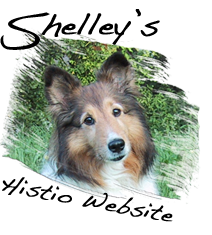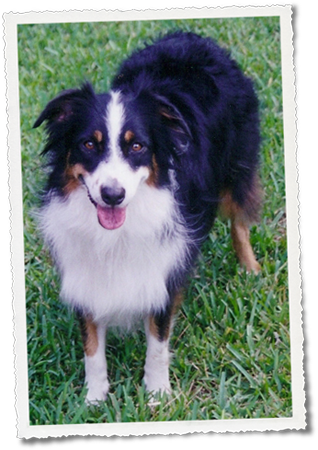
HOME
 YOUR HISTIO STORY
YOUR HISTIO STORY
I am looking for similarities
in all individual cases of
Histiocytic diseases.
I wonder if we all tell our
stories we might come up
with some commonality
between the specific
situations in which all of
our pets got this disease.
So please email me the
details and I'll put your
pets story on Shelley's
Histio Website
 UW HISTIO VERHAAL
UW HISTIO VERHAAL
Ik ben op zoek naar
overeenkomsten in alle
individuele gevallen van
Histiocytose.
Ik hoop dat wanneer wij
onze Histio verhalen
vertellen, wij overeen-
komsten ontdekken over
de manier waarop onze
huisdieren deze ziekte
hebben opgelopen.
Stuur mij de details en
ik zal het verhaal van uw
huisdier op de Histio
website van Shelley zetten.
 WARNING !
WARNING !
These stories are all
different. Individual
symptoms, situations
and circumstances
may vary and response to
therapy is not always the
same.
- Disclaimer -
 WAARSCHUWING !
WAARSCHUWING !
Deze verhalen zijn allemaal
verschillend. Individuele
symptomen, situaties en
omstandigheden kunnen
verschillen en de reactie
op therapie is niet altijd
hetzelfde.
- Disclaimer -
HISTIOCYTOSIS IN
OTHER LANGUAGES
German - Hund
Maligner Histiozytose
French - Chien
l'Histiocytose Maligne
Italian - Canis
Maligni Histiocytosis
Spanish - Perros
Histiocitosis Maligna
Dutch - Hond
Maligne Histiocytose
HOME
Koira
Malignant Histiocytosis
Australian Shepherd
Female
August 25, 1999 – January 30, 2010


Story told by Frank S.
We had no real intention of buying a dog at a puppy store. We were just in the right place at the right time. The female Australian Shepherd puppy just captured our interest and then our hearts after three trips to the strip mall to visit her. We named her 'Koira', which is Finnish for dog, and welcomed her into our home. We have no doubt that her youthful antics and sharing of high protein/fat puppy food kept our old dog Rainier alive with lung cancer far longer than anyone would have figured. We brought Koira home just before Thanksgiving, 1999. She was about 11 weeks old.
She was a typical Aussie with endless energy, mischievous intelligence, and a sense of humor. In time she became so attached to our swimming pool that we figured she must have some Lab in her. Koir'’s best buddy Rainier died at age 15 the following June. The puppy was despondent and lonely, like us. We had become attached to the breed and adopted another young female through an Aussie rescue group in Florida. We named her Aspen. The two quickly became best buddies and playmates.
Both dogs lit up our lives with daily walks, swim sessions, trips to the dog park, and family vacations. They had frequent romps and swims with their neighborhood dog friends, a lovable pack of Chocolate Labs. Time marched on much too quickly. In 2006, we accepted a corporate relocation and moved from Florida to Delaware.
In the summer of 2008 we realized with sadness that Koira was no longer a young and spunky dog. We had to start limiting the extreme nature of her athletic activities or she would be lame the next day. I think this was just part of the natural aging process. We had our first scare in October, 2008 with two episodes that were characterized as pre-seizure syndrome. She would temporarily have trouble walking and not have good control of her hind legs. The symptoms would disappear after a number of minutes. Blood testing and a follow up ultrasound were inconclusive as to the cause. The ultrasound did show an enlarged spleen and some abnormalities on the liver. We decided not to pursue a biopsy at that time, since it didn't relate to the original symptoms. We decided to monitor the situation and had valium just in case we needed it for a potential seizure. The symptoms didn't return for six months.
We had another similar spell in the spring of 2009. Again, the symptoms disappeared and she seemed normal enough. In late fall we noticed increasing lameness. The diagnosis was arthritis in both front legs. We experimented with different NSAID's but they didn’t seem to help much.
Everything turned dramatically downhill on Christmas Day, 2009. She alternated between being agitated and listless. Her appetite decreased while the lameness increased.
A round of ultrasound assisted needle aspirations gave us a diagnosis of primary liver cancer. The oncology vet didn't think the diagnosis fit the progress of the disease because the diagnosed cancer, while very serious, was typically slow growing. Her rapid onset of symptoms and deterioration didn't fit the disease.
We resubmitted to a second round of ultrasound and needle aspirations. The diagnosis came back as malignant histiocytosis in the liver and lymph nodes. The oncology vet recommended chemotherapy to 'buy us a little time' but told us that there was no cure. We chose to keep her as comfortable with an assortment of vet-provided medications for as much time as we had left together.
Koira declined so fast. We really didn't have time to emotionally prepare for the end. On January 30th both my wife and I knew it was time. Our poor girl couldn't walk, wouldn't eat, and couldn't even stand properly. She had lost motor control of the joints in one of her rear legs. It was time to end her suffering.
We'll always remember our girl Koira as the one with endless energy, playful enthusiasm, and a great sense of humor. She loved to watch TV and bark at politicians. We miss her so much. We're now focusing our energies on spending quality time with and providing a good home for her sister Aspen.

